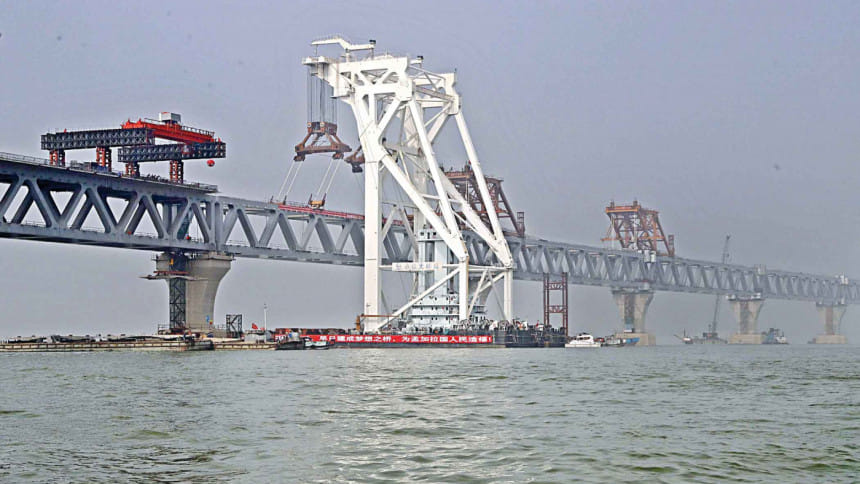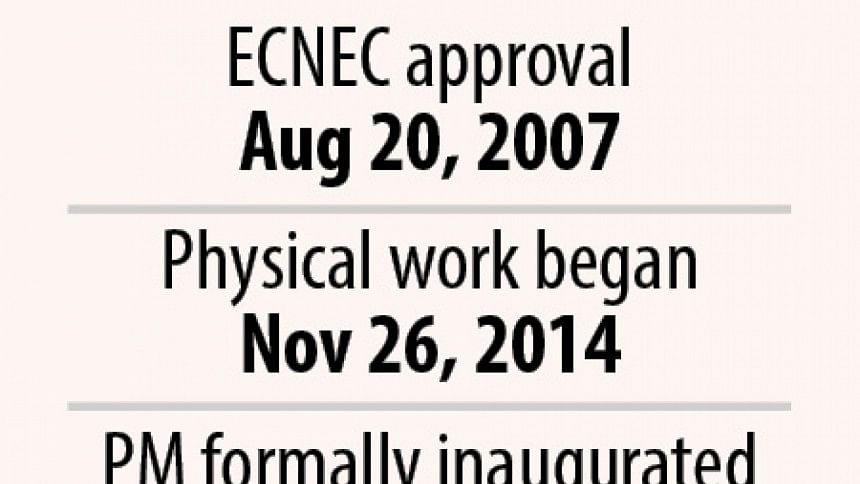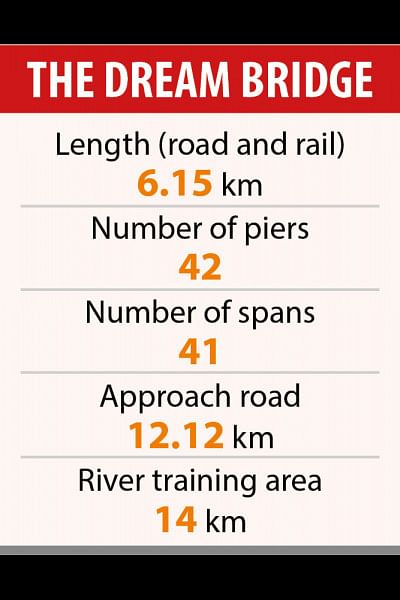Mission Impossible accomplished

Mizanur Rahman stood still, gazing with awe from the bank of the Padma river at the specialised floating crane laying down the last span on the mega structure yesterday.
As the 150-metre span was finally placed on pillars 12 and 13 at the Mawa end, he was thrilled and elated to see the full structure of the Padma bridge.
"Look, here is our dream bridge standing tall. What a great engineering feat it is!" marvelled Mizanur, pointing to the 6.15km bridge that became fully visible for the first time.
The Padma bridge is not a dream anymore; it's now a reality. The mega bridge is expected to be a huge boon for the underdeveloped south and south-western region of Bangladesh.
But decades ago, it was rather an audacious dream, a daunting challenge to tame the turbulent river. Crossing the mighty Padma has always been strenuous and sometimes dangerous due to unreliable and limited ferry connections and long waits for crowded boats and launches.
"I still remember it took around three hours to cross the river by the ro-ro ferry when I first came to Dhaka in 1998. Twenty-two years down the line, it still takes a similar amount of time now," said Mizanur, a private jobholder hailing from Madaripur.
"But once the Padma bridge opens to the public, we can go home in a few hours and come back to Dhaka the same day. Our travel time will be slashed immensely."
The two-level steel truss composite bridge -- the top deck accommodating a four-lane highway for vehicles and the lower deck for a set of railway tracks -- is the culmination of years-long efforts and an impressive engineering feat.

The authorities expect to open it to the public in the first half of 2022.
The bridge that connects Dhaka to 21 southern districts is a potential catalyst for major economic change in the lives of over 30 million people living in the region and will give a major boost to trade and economic activities.
The Tk 30,193-crore bridge will connect multi-lane expressways and railway lines with Dhaka to Mongla port and the largest deep-sea port at Payra.
It will be one of the major transport corridors linking Bangladesh with India, Nepal and Bhutan besides enhancing regional trade and collaboration along the Asian Highway and the Trans-Asian Railway Network.
REALISING A DREAM
A bridge across the mighty Padma had been in talks since the mid '90s. The idea gained momentum in 1997 when the construction of Bangabandhu Bridge over the Jamuna was nearing completion, ushering in new hope and optimism among people of the south-western region.
The pre-feasibility study of Padma bridge was conducted in 1998 and 1999. The government then approached the Japanese government for financial and technical assistance for a feasibility study, which was conducted by Japan International Cooperation Agency (JICA) between 2003 and 2005.
Following further studies and exploring financing options, the government approved the Padma Multipurpose Bridge Project worth Tk 10,161 crore on August 20, 2007 to be built with donor assistance.
On January 11, 2011, the Padma Bridge Project was revised with the estimated cost raised to Tk 20,507 crore, mainly to incorporate a rail line into the bridge.
The government concluded loan agreements with four development partners in early 2011 and an agreement for $1.2 billion was signed with the World Bank on April 28, 2011.

SETBACKS
But the billion-dollar project became uncertain in September 2011, when the lead donor, WB, suspended its promised $1.2 billion loans on allegation of corruption conspiracy, which the government denied.
The ruckus resulted in filing of corruption cases against some project officials and resignation of then communications minister Syed Abul Hossain. Yet, the WB cancelled its financing in June 2012.
Other financiers -- Asian Development Bank (ADB), JICA and Islamic Development Bank (IDB) -- also cancelled their loan proposals, leading to the project being stalled for some time.
However, the allegations against the government officials were later found to be untrue by the Anti-Corruption Commission and a Dhaka court. A Canadian court also found no proof of graft conspiracy involving the project.
Then, in July 2012, Prime Minister Sheikh Hasina took a bold decision to go ahead with implementation of the project with the country's own funds.
Two Chinese companies -- China Major Bridge Engineering Company Ltd and Sinohydro Corporation Limited -- were appointed for two major works, the construction of bridge and river training.
In December 2015, Sheikh Hasina inaugurated the main construction work of the most challenging engineering project of the country, having one of the deepest foundations in the world.
DAUNTING CHALLENGES
But the project has been a huge engineering challenge as the mighty Padma carries a large volume of sediment, making its bed soft and tricky to build on. The most difficult part was river training and piling because of the strong river currents and erosion.
The second major challenge was to drive in the piles which will carry the load from road and rail traffic as well as the weight of the bridge to the foundation.
And the situation was further complicated in 2016 when differences emerged between the information obtained through geotechnical investigation in the design phase and that in the construction phase of piles of the bridge.
The project authority had to change the design of the 22 bridge piers, causing a further delay. The first span was installed in September 2017.
By this time, the project costs went up to over Tk 30,000 crore.
As the project progressed smoothly, then arrived the Covid-19 pandemic at the shores of Bangladesh. Yet the work continued, albeit slowly due to a shortage of workers -- Chinese and local -- and poor supply of construction materials.
The project gained pace after the end of the Covid-19-induced two-month shutdown and return of Chinese nationals. Then, again, the strong currents in the Padma started causing problems but the work again gathered momentum.

NEXT STEPS
Installation of the roadway deck and railway stringers is going on now. Of the 2,917 roadway slabs, 1,333 were installed as of yesterday while 1,942 out of 2,959 railway slabs were installed.
Some other work, including installation of electricity and gas lines, has to be completed before the bridge is opened.
However, the railway stringers, which went into the Padma due to erosion at a yard, will have to be brought from Luxembourg, which will cause some delay, officials said.
Talking to the reporters on December 7, Road Transport and Bridges Minister Obaidul Quader said it would take 10 to 12 months to complete other work after installation of the last span, which was placed at 12:02pm yesterday.
However, a top official of the Bridge Division told this newspaper last month, "It will take 12 to 14 months to complete all works. It may be opened [for the public] in the first half of 2022."
But Mizanur is as eager as ever. "I am really looking forward to the opening of the dream bridge."


 For all latest news, follow The Daily Star's Google News channel.
For all latest news, follow The Daily Star's Google News channel. 



Comments